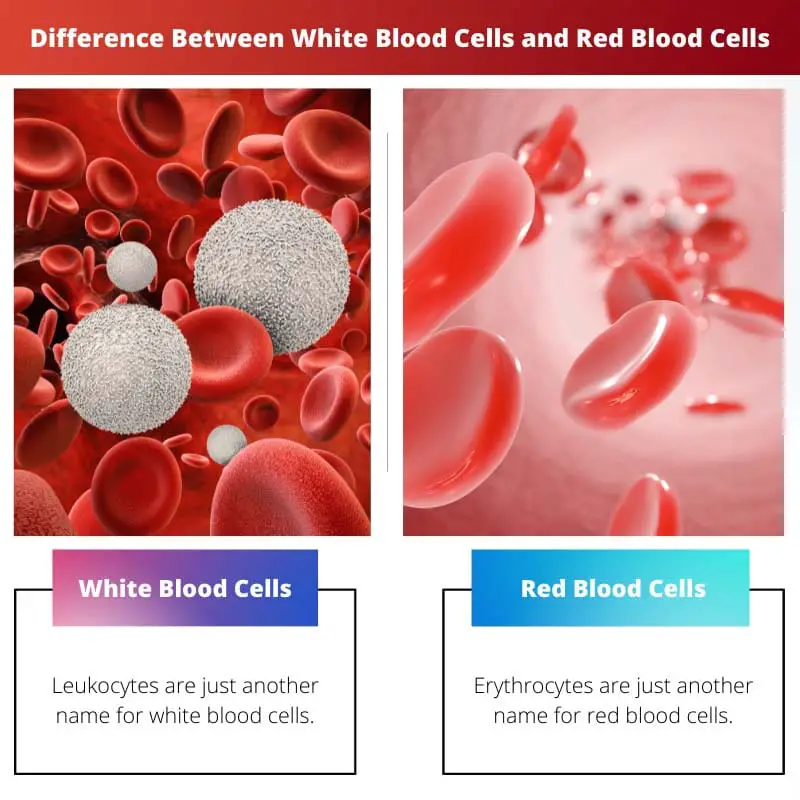Blood plays a vital role in the human body because it is a fluid connective tissue. The primary functions performed by it are transportation, pH level regulation as well as regulation of body temperature.
Blood consists of mainly four primary components: plasma, red blood cells, platelets, and white blood cells.
In terms of human body blood, around 55% makes up of plasma. In this article, the main focus is on differentiating white blood cells and red blood cells. Apart from their functions and structures, there are many other differences to cover up.
Key Takeaways
- White blood cells are part of the immune system and protect the body against infection and diseases.
- Red blood cells transport oxygen to tissues and organs, removing carbon dioxide from the body.
- The primary difference between the two cell types is their function, with white blood cells focused on immunity and red blood cells on oxygen transportation.
White Blood Cells vs Red Blood Cells
Red blood cells are responsible for carrying oxygen from the lungs to the body’s tissues and removing carbon dioxide from the body. White blood cells are a crucial part of the body’s immune system and help to fight infections and diseases. Some of its types include neutrophils, lymphocytes, etc.

Leukocytes are just another name for white blood cells. In the human body, against any infections, they perform as a defence system.
Antibodies are the specific kinds of proteins produced by this cell, which fight and identify pathogens that invade the human body.
Erythrocytes are just another name for red blood cells. It stores haemoglobin, which is a pigment of the respiratory that binds to carbon dioxide or oxygen molecules.
This aids oxygen for transportation to the different organs and tissues of the human body. Carbon dioxide is also taken away from different tissues and organs to be replenished in the lungs.
Comparison Table
| Parameters of Comparison | White Blood Cells | Red Blood Cells |
|---|---|---|
| Color | Colorless | Red |
| Shape | Rounded in shape. Sometimes, they are amoeboid or irregular-shaped. | Circular and biconcave disc-shaped. |
| Lifespan | 5-21 days | 120 days |
| Systems | In both lymphatic and cardiovascular systems | In the cardiovascular system |
| Motility | Sometimes motile | Not motile |
What are White Blood Cells?
In blood, white blood cells are kind of cells of blood that are involved in the mechanism of defence of the animal body by destroying pathogens. In terms of size and shape, they differ from each other. There are multiple lobes in some of the white blood cells.
Some of the nuclei are round and large. These cells can be further classified as agranulocytes and granulocytes. In the cytoplasm, granules are contained in some of the white blood cells.
That’s why they are known as granulocytes. On the flip side, these granule-like structures do not possess agranulocytes.
There are mainly three types of granulocytes, namely, eosinophils, neutrophils, and basophils. Monocytes and lymphocytes are the other two types of agranulocytes. Among the total blood volume, white blood cells consist of 1%.
After their lifespan ends, they are destroyed in the lymphatic system. With age, their lifespan changes. For instance, a newborn baby has a high count of white blood cells compared to an adult. With pregnancy, the count of these cells also changes.

What are Red Blood Cells?
Red blood cells are the kind of cells found in animal blood, pre she ate Ng into the transportation of the SS, around 6 μm is the diameter of this cell, which allows squeezing through blood capillaries small in size in the body.
According to per cubic millimetre of blood, there are red blood cells around 4 to 6 million.
Macrophages in the liver and spleen are involved in the old blood cells cleaning off from the system. Due to the presence of pigments such as hemocyanin, hemovanadin, chlorocruorin, hemerythrin, and haemoglobin which makes their color is different.
In vertebrates, haemoglobin is found, which gives red blood cells the color which is bright red as well as the blood of the vertebrate. Hemocyanin is contained in Mollusks, which gives their blood a blue color. In tunicates and ascidians, hemovanadin is found with a mustard yellow color.
Erythropoiesis is the process that helps in the production of red blood cells. With the help of this process, red blood cells are produced in the amount of 2 to 3 million and by bone marrow released into the circulation.
Mammals’ mature red blood cells lack a nucleus as a differentiation for the transportation of oxygen.

Main Differences Between White Blood Cells and Red Blood Cells
- When it comes to functions, white blood cells are involved in the mechanism of defence. In contrast, red blood cells are involved in the transportation of gases, minutely carbon dioxide and mainly oxygen.
- The production of white blood cells takes place in the bone marrow. On the other hand, during the embryonic period, red blood cells are produced in the spleen and liver. In adults, it is produced in the red bone marrow.
- White blood cells are found in mainly five types: eosinophils, neutrophils, monocytes, basophils, and lymphocytes. Meanwhile, only a single type of red blood cell is found in a specific species.
- In terms of special components, white blood cells consist of antigens for HLA or human leukocytes antigen complex. Conversely, haemoglobin is a special component in red blood cells.
- White blood cells can come out from vessels or blood into the lymphatic system and connective tissues. On the flip side, red blood cells circulate only inside the blood vessels.

- https://www.nature.com/articles/204793a0
- https://science.sciencemag.org/content/164/3880/717.abstract